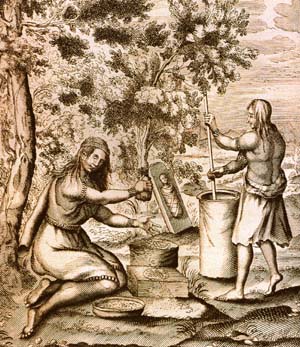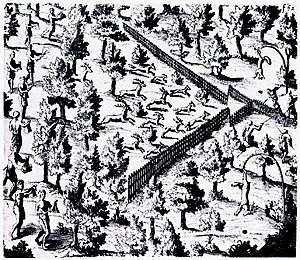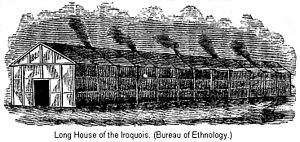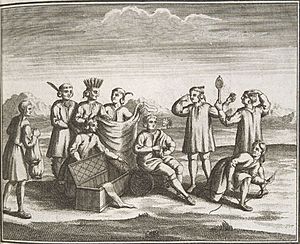Economy of the Iroquois facts for kids

The economy of the Haudenosaunee, also known as the Iroquois, was historically based on working together as a community. They combined farming (growing plants) with hunting and gathering food from nature. Some people have even called their economy a form of "primitive communism," meaning everyone shared resources. The Iroquois Confederacy tribes lived in what is now New York State and near the Great Lakes. This powerful group originally had five tribes: the Mohawk, Onondaga, Oneida, Cayuga, and Seneca. They formed an alliance long before Europeans arrived. The Tuscarora tribe joined them later in the 1700s, becoming the sixth nation.
The Iroquois people were mainly farmers. They grew the "Three Sisters": corn, beans, and squash. These were common crops for many Native American groups. The Iroquois developed special ways of life, including unique ideas about owning and managing land. Their system was very different from the way most Western societies think about property. It included things like common ownership of land, a clear division of labor between men and women, and trade mostly based on giving gifts.
When Europeans arrived in the early 1600s, it greatly changed the Iroquois economy. At first, the Iroquois became important trading partners. But as European settlements grew, it upset the balance of their traditional economy. By 1800, after the American Revolutionary War (where most Iroquois nations supported the British), the Iroquois were moved to reservations. These were mainly in New York (USA) and Quebec and Ontario (Canada). They had to change their old economic system to fit these new conditions. In the 1900s, some Iroquois nations in the United States used their special status as sovereign nations to open casinos and recreation places. These businesses have brought in more money than other types of work. Many Iroquois individuals also joined the larger economies in cities outside the reservations.
Contents
How did the Iroquois own land?
The Iroquois had a system where land was mostly owned by the community. A French missionary named Gabriel Sagard described how the Huron people, who were similar to the Iroquois, managed their land. The Huron had "as much land as they need[ed]." This meant they could give families their own plots of land and still have a lot of extra land owned by everyone.
Anyone in the Huron tribe could clear land and farm it. They kept the land as long as they actively farmed it. If they stopped using the land, it went back to being owned by the community. Then, anyone else could take it over. Even though some land was for individual families, the main idea was that people living in the same longhouse (which held many families) shared all the food they grew.
The Iroquois had a similar system for land. The entire tribe owned all the land. They would then give parts of it to different clans. These clans would then divide the land among their households for farming. Every few years, the land would be given out again to different households. A clan could ask for land to be redistributed when the Clan Mothers' Council met. If a clan didn't take care of their land, they would be warned. If they continued to misuse it, the Clan Mothers' Council could take the land and give it to another clan. Land ownership was mainly a concern for women because it was their job to grow food.
The Clan Mothers' Council also set aside certain areas of land. Women from all the different clans would work these lands together. Food grown on these special lands, called kěndiǔ"gwǎ'ge' hodi'yěn'tho, was used for festivals and large council meetings.
How did the Iroquois divide work?
The division of labor in Iroquois culture showed how men and women had different but equally important roles. This was like their belief in the twin gods, Sapling (East) and Flint (West), who represented two balancing halves. Women did all the work in the fields, including planting, taking care of, and harvesting crops. Men did all the work related to the forest, like making things from wood.
Iroquois men were responsible for hunting and fishing, trading, and fighting. Women took care of farming, gathering food and preparing it, raising children, and housekeeping. This division of labor by gender was the main way work was shared in Iroquois society. When Europeans first met the Iroquois, women produced about 65% of the goods, and men produced 35%. Because they worked together so well, hunger was very rare. Early European settlers often admired how successful the Iroquois were at producing food.
The Iroquois work system also showed their communal land system. Since they owned property together, they also worked together. Women did hard work in large groups, moving from field to field to help each other. They would plant the fields together, with a "mistress of the field" giving out a certain amount of seeds to each woman. The Iroquois women in each farming group would choose an older, active member to be their leader for the year. They would agree to follow her directions. Women also did other work cooperatively. They cut wood for their families individually, but their leader would oversee carrying the wood back to the village together. This collective effort prevented "every jealousy of one having done more or less work than another," according to Mary Jemison, a white woman who lived with the Seneca tribe.

Iroquois men also worked together. They acted as a group during military actions. Other jobs for men, like hunting and fishing, also involved working together. Men often organized as a whole village rather than just by clan. They formed hunting parties and used teamwork to catch many animals. One story tells of a hunting party that built a large brush fence in a forest to form a 'V' shape. They would set a fire across from the open side of the 'V', forcing animals to run towards the point where the hunters waited. They could kill one hundred deer at a time this way.
Men also fished in large groups. Fishing trips included men in canoes using weirs (traps) and nets to cover entire streams. They could catch many fish, sometimes a thousand in half a day. Any animals or fish caught by a hunting or fishing party were considered common property. The leader would divide them among the group or take them to the village for a feast. While hunting and fishing weren't always group efforts, the Iroquois generally had more success when they worked together.
How did the Iroquois trade?
The Iroquois traded their extra corn and tobacco. They exchanged these goods for animal furs from tribes to the north and for wampum (beads made from shells) from tribes to the east. The Iroquois often used present-giving more than other ways of trading. This gift-giving showed the idea of reciprocity in Iroquois society, meaning that people expected to give and receive in return.
An exchange would start with one clan giving a present to another tribe or clan. They expected to receive something they needed in return. This type of trade was connected to the Iroquois culture of sharing property and working together. There was no strict agreement, but one service was done for the community or another person, with the expectation that the community or another individual would give back. Trading with outsiders was one of the few chances for individuals to start their own businesses in Iroquois society. A person who found a new trading route had the special right to trade along that route in the future. Often, clans would work together to control a certain type of trade.
When Europeans arrived, it created many new opportunities for trade. Furs were in high demand in Europe. Europeans could get them cheaply from Indigenous Peoples in exchange for manufactured goods that Indigenous Peoples could not make themselves. However, trade did not always benefit the Native people. The British took advantage of the gift-giving culture. They gave the Iroquois many European goods, making them dependent on items like rifles and metal axes. For a while, having guns gave the Mohawk and other Iroquois tribes an advantage over others, and they became very involved in trading. The British mainly used these gifts to get the Iroquois to help them fight against the French.
How did the economy affect Iroquois culture?
The way the Iroquois economy was set up created a special way of thinking about property and work. The risk of theft was almost zero. This is because individuals owned very little, mostly just basic tools that were so common they weren't valuable. The only goods worth stealing would have been wampum. While a society without theft is great, communal systems like the Iroquois are sometimes criticized for giving people less reason to work hard as individuals.
For the Iroquois to succeed without individual rewards, they had to develop a strong community work ethic. Being productive became a sign of being a good person. The ideal Iroquois man was a skilled warrior and a good hunter. The perfect woman was excellent at farming and housekeeping. By focusing on how useful a person was to the community, the Iroquois encouraged their members to contribute. This was true even though everyone received similar benefits, no matter how hard they worked.
Because of their communal system, the Iroquois had a strong tradition of personal responsibility. Iroquois boys were taught to be self-disciplined, self-reliant, and responsible, as well as calm and strong. The Iroquois tried to remove any feelings of being dependent during childhood. Instead, they encouraged a desire for responsibility. At the same time, children had to be part of a communal culture. They were taught to think as individuals but to work for the community.
Land management after Europeans arrived
The Iroquois system of land management changed somewhat after they met Europeans. The Mohawk were the first to deal with them and "sold" some land to settlers. However, it's likely that neither side fully understood the other's idea of property.
After the American Revolutionary War, the winning Americans forced the Iroquois nations onto much smaller reservations. This happened even to the Oneida and Onondaga, who had supported the Americans. Most of the other Iroquois nations had to give up their land and moved to Canada. There, they received some land from the British Crown, in addition to existing settlements.
The Iroquois had a system where land was owned by the community and could be used by its members as needed. While this system wasn't completely collective (land was given to individual family groups to use), the Iroquois didn't see property as something to be bought and sold, like Western cultures do. Despite the influence of Western culture, the Iroquois have kept their unique view of property over the years.
Doug George-Kanentiio, a modern Mohawk writer, explains his view of Iroquois property: The Iroquois have "no absolute right to claim territory for purely monetary purposes." He says, "Our Creator gave us our aboriginal lands in trust with very specific rules regarding its uses. We are caretakers of our Mother Earth, not lords of the land. Our claims are valid only so far as we dwell in peace and harmony upon her."
In 1981, the Iroquois Council of Chiefs (or Haudenosaunee) shared similar ideas. The Council said that "Western European concepts of land ownership" were different from the Iroquois view that "the earth is sacred." They believe the earth "was created for all to use forever—not to be exploited merely for this present generation." Land is not just something to be bought and sold. They stated, "Under Haudenosaunee law, 'Gayanerkowa,' the land is held by the women of each clan. It is principally the women who are responsible for the land, who farm it, and who care for it for the future generations." When the Confederacy was formed, the separate nations became one union. The land of each nation became Confederacy land, even though each nation still had a special interest in its historical territory. This statement shows the Iroquois' unique view of property.
The system of the Six Nations of the Grand River (two Iroquois reservations in Canada) combined the traditional Iroquois property structure with their new way of life on a reservation. The reservation was set up by the British Crown in the 1700s after the American Revolutionary War. These agreements gave ownership of the lands to the Six Nations of the Iroquois as a group. Individuals were given permission to use a specific plot by the Confederacy. The Iroquois idea that land became yours if you cared for it and went back to public control if left alone was used in their reservation property law. In one land dispute, the Iroquois Council sided with someone who had improved and farmed the land over someone who had left it unused.
The natural resources on the land are considered to belong to the tribe as a whole, not to the person using that specific piece of land. For example, the Iroquois leased the right to take stone from their lands and set payments for all the stone produced. After natural gas was found on the reservation, the Six Nations took direct ownership of the gas wells. They only paid people who had wells on their land for any damage caused by gas extraction. This setup was very similar to their land system before contact with Europeans, where the tribes owned the land and allowed its use, but not full ownership.
What is the Iroquois economy like today?
Many Iroquois people are now fully part of the larger economies of the United States and Canada. For others, their economic life is more focused on the reservation. Whether they are directly involved in the outside economy or not, most of the Iroquois economy is now greatly affected by national and world economies. Iroquois people have been involved in the steel construction industry for over a hundred years. Many men from the Mohawk nations have worked on tall buildings like the Empire State Building and the original World Trade Center.
On the reservations, which are sometimes far from big cities, the economic situation has often been difficult. For example, the U.S. side of the Mohawk St. Regis reservation in northern New York recently had unemployment as high as 46 percent. However, in April 1999, the St. Regis Mohawks opened the Akwesasne Mohawk Casino. It has been updated in 2011 and 2012 to make the hotel, services, and gaming area bigger. The casino also hires tribal members and people from the local community.
Many reservations now have successful businesses. The Seneca reservation includes the City of Salamanca, New York, which is a center for the hardwood industry. The Seneca use their special status as a sovereign nation to sell gasoline and cigarettes without taxes. They also run large bingo games. The Senecas have opened several Indian casinos, including the Seneca Niagara Casino in Niagara Falls, New York and one in Salamanca. In 2007, the Seneca opened a third casino in Buffalo, the Seneca Buffalo Creek Casino.
The Oneida also operate casinos on their reservations in New York and Wisconsin. The Oneida are one of the largest employers in northeastern Wisconsin, with over 3,000 employees. This includes 975 people working in their tribal government. The Tribe manages more than $16 million in government and private grants. They also run many programs, including those allowed by the Indian Self-Determination and Education Assistance Act. The Oneida's businesses have brought millions of dollars into their community and improved their standard of living.
See also
 In Spanish: Economía iroquesa para niños
In Spanish: Economía iroquesa para niños



